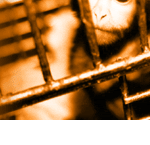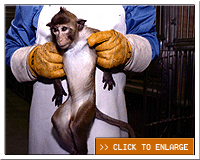According to the National Institutes of Health (NIH), Acquired Immunodeficiency Syndrome (AIDS) has affected more than 60 million people since it was first identified in 1981, and has killed approximately 25 million men, women and children, making it a key field of medical study.1
Much of money invested in AIDS research is directed into animal experiments, even though the animal model has failed to give us a cure or useful treatment options. The AIDS research industry’s reliance for animal experimentation is costing billions of tax dollars and millions of human and animal lives.
Some vivisectors themselves have acknowledged this. According to Dr. Mark Feinberg, an AIDS researcher at the Emory Vaccine Center at Emory University:
"What good does it do you to test something in a monkey? You find five or six years from now that it works in the monkey, and then you test it in humans and you realize that humans behave totally differently from monkeys, so you've wasted five years." 2
AIDS is believed to be caused by human immunodeficiency virus (HIV). HIV weakens the immune system, leaving the afflicted person vulnerable to opportunistic infections--illnesses such as pneumonia, which people with healthy immune systems can recover from, but progress unchecked in those with impaired immune systems.
Click here to read more about HIV and AIDS.
IN THE AIDS LABORATORIES
Most of AIDS research attempts to understand how HIV destroys the immune system. Possible treatments are another focus, seeking new drugs and vaccines to halt or slow the progression of the disease. These experiments often use animals, primarily cats, primates and rodents.
To read how animals are being abused in AIDS experiments, click here.
DANGERS IN GENERALIZING FROM ANIMAL TO HUMAN
Humans have suffered from researchers' reliance on animal models in many ways. Animal data has given us misleading information about how AIDS is transmitted, how it manifests, and how it can potentially be treated.
Click here to learn more.
REPLACING ANIMALS IN AIDS RESEARCH
Even when deliberately infected with various strains of immunodeficiency viruses, animals do not succumb to AIDS. Humans are the most vulnerable species to HIV, making human-based research the only approach with the potential to treat and cure AIDS.
Click here to learn how non-animal methodologies have contributed to AIDS research.
1. Office of AIDS Research, National Institutes of Health, "Fiscal year 2004 Plan for Research," (2003).
2. Atlanta Journal Constitution, (21 September 1997).
This website is dedicated to the memory of Matt Fancera.











